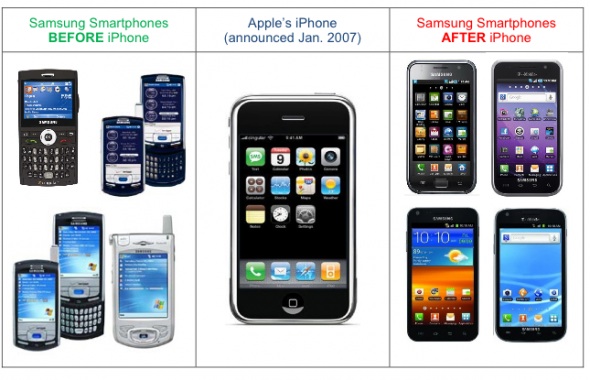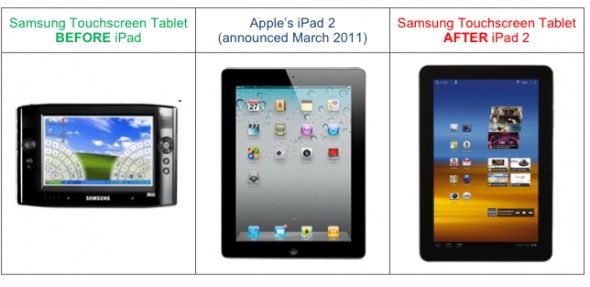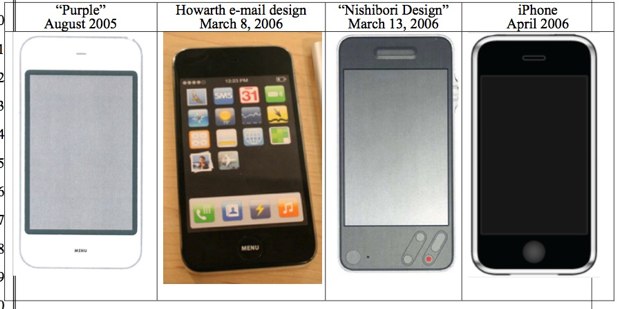Apple Vs Samsung: ...
With all the hype, the relentless accusations, judgments and courts and we ended up losing. Here's an excellent article by iGeneration ( original article ) that will be help you make the point well above Atlantic ...
Even if defeated in his two trials against Apple, Samsung wins. The Korean manufacturer has exposed many preproduction iPhone and iPad and the Cupertino forced to reveal some of his secrets best kept. In doing so, Samsung has certainly raised the ire of Judge Lucy Koh, but no matter: after many setbacks, the strategy of scorched earth was the only option.


Lawsuit Against Apple Samsung takes place at the court Robert F. Peckham, in San Jose (California). Beck Diefenbach picture.
Prolegomena caricatures
 Open from Monday, July 30, the trial is presided over by Judge Lucy H.Koh federal court for the Northern District of California (San Jose). A judge known for its inflexibility: it was refused such as Apple, Google, Intel, Adobe, Intuit, Lucasfilm and Pixar can settle amicably their illegal cartel case, forcing them to go to trial . An exasperated judge too: it must indeed manage 19 cases cross between Apple and Samsung Vice versa, 19 cases have turned the settlement account as playground.
Open from Monday, July 30, the trial is presided over by Judge Lucy H.Koh federal court for the Northern District of California (San Jose). A judge known for its inflexibility: it was refused such as Apple, Google, Intel, Adobe, Intuit, Lucasfilm and Pixar can settle amicably their illegal cartel case, forcing them to go to trial . An exasperated judge too: it must indeed manage 19 cases cross between Apple and Samsung Vice versa, 19 cases have turned the settlement account as playground.
Thus, even before the jurors are invited to enter the courtroom, counsel for Samsung has asked the judge for agreeing to allow the introduction of internal documents showing the company smartphones and rectangular black before developing iPhone. A motion that the judge had already rejected three times, Samsung has submitted those documents too late "does not make me punish you," she intima, asking the lawyer to sit down. It also prohibits Samsung to use clips from 2001: A Space Odyssey , looking quite annoyed.


A tablet in 2001 . We meet as a videoconference, a personal assistant, and an inter-dimensional travel psychedelic. All things reality today.
The argument of Apple revolves around two points: the fact that Samsung violated its intellectual property well, and that patents Samsung at stake are not relevant. To prove the first point, the legal team says the Apple iPhone was a radically new product: use the touch screen as a primary area of interaction required an innovative design, a single interface, and concepts unpublished. How to prove that the Samsung has knowingly copied? In internal documents, the designers of the Korean company admit to being in "crisis" facing the "paradise" that is the iPhone. They ensure that the equipment is "easy to copy" - later, Google will ask Samsung retoquer its tablet, too close to the iPad.
This 18-minute video was designed to be distributed to all jury trials around the patents and industrial property. Lucy Koh has seen fit to get it to trial.
It's appearance, but also attacks on Apple features: documents show that Samsung has consciously decided to use the double-tap to zoom in or inertial scrolling, inaugurated by the iPhone. Samsung assures that patents of Apple on the subject are not valid (the judge in Koh currently decided otherwise), the Cupertino company will instead try to demonstrate they underpin the identity of IOS.Because the issue is that of the identity of Apple products ( trade dress ) and how to use them (look-and-feel ), that distinguished the iPhone from its competitors. Lawyers for the Cupertino ensure that it is now possible to produce a phone that can work differently and do not slavishly plunder the intellectual property of Apple, after all, before the iPhone, diversity was put in the phone market.


A now classic image again by Apple's lawyers.
To remove the second point, Apple's lawyers note that Samsung has not challenged for patent infringement, but cons-attacked. Five patents presented by Samsung, none were filed after 2007, and the Korean company does not use them all elsewhere. Worse: they cover standards (including 3G), they should be open to a FRAND license - a license application or Samsung $ 12 per unit sold (2.4% of the price), while the component in question is $ 10 ! Samsung is accustomed to doing, and the competition authorities the U.S. and Europe already investigating this practice : if the first point is open to interpretation, the Korean company will have great difficulty in convincing the world on this subject.


The same for the tablets. The tablet Samsung Q1 is left (€ 1,200 at the time), based on the Microsoft Origami concept, which was to launch the fashion of UMPCs (ultra mobile PC).
Samsung is the contrary to show that the design of the iPhone is nothing revolutionary: we have heard mentioned for example the LG Prada (2005) and was presented with documents showing large-screen smartphones in development in 2006. "We're not saying the iPhone is not a great product. This is a great product and a product "inspiring". This is how competition works and what does not violate industrial property. "Summarize the lawyers of Samsung, with internal Apple documents resulting from the dismantling of the Galaxy S:" Apple has dissected the Galaxy S. Apple accuses us of having dissected the iPhone. Does that mean that Apple has done something wrong?No, this is the competitive analysis. It happens all the time, and there is no harm in that. "


A picture released by Samsung to prove she had the concepts of large-screen smartphones in 2006. Problem: Samsung had not obtained permission to distribute this document.
The identity of Apple products? Lawyers for the Samsung sweeps with the back of the hand, "there is no evidence" that a customer will ever have confused an Apple product and a Samsung - no mention that they were sometimes themselves themselves unable to do so, and that the documents show that the main reason for returning the shelves at Best Buy Samsung ... is that customers had taken them for the iPad. In detailing the registered designs, the use by lawyers Samsung against a strategy that has already proven itself in Europe: they point to any small differences in a precise and tangible, while Apple will attempt to defend an identity and more general intangible. This will be the big issue of this trial.
A battle of scavengers
At least if this trial is not shortened: Samsung has ignored the ban on Koh judge and his lawyers have communicated to the press documents showing she was working on large-screen smartphone before the presentation of the iPhone. What cause the ire of the judge, already quite annoyed by the inability of both parties to find common ground. Attorneys would notably include the Samsung F700 - this phone has been many montages supposed to show that Apple had copied the iPhone on Samsung.


You've probably crossed this image.
Problem: this image is absolutely not the reality. The F700 has actually been presented for the first time one month after the iPhone in February 2007. Its home screen is not the grid of icons, which also differs greatly from that of IOS, but a screen widgets. Moreover, it is a slider phone horizontally!Some do not hesitate to say that Judge Koh was a gift to Samsung F700 include the amount to go in the direction of Apple on the subject of the diversity of forms.


The F700, as it was in fact promoted at the time. This time we have struggled to find a resemblance to the iPhone.
In response to the unauthorized publication of these documents, Apple has asked the court to sanction Samsung in closing the case by a decision declaring that the Korean company violates industrial property of the Cupertino company, and that patents are Apple valid - in short, Apple asks for the procedural defect. Samsung has already been sanctioned for destroying evidence and was called to order by Judge Koh after sending to the press, once again, this time the documents belonging to Apple. Because the damage is already done: even if Samsung should lose this case, for procedural or regular, small Apple secrets were revealed. Samsung had managed to obtain documents showing an iPhone inspired by the 2006 Sony style , to cast doubt on the famous "Apple ID. "In doing so, she simply forced Apple to reveal the Purple prototype, codenamed Project iPhone, dating from 2005 - and thus prove that the design of the iPhone 4 was already in the pipeline.




The iPod brand? The term iPhone came a little later, and was rarely used on the prototypes, in order to test them without arousing suspicion. We understand better the chronologies of rumors about the iPod touch, which preceded those of a few years around the iPhone.
In all, more than 40 prototypes of the iPhone and iPad that were revealed in this process. They provide insight into how the process design of Apple, especially since many designers have had to testify. We know for example now that Apple has always worked on an iPhone to both sides of glass - and therefore that the first three generations of iPhone were transition models, also developed late in the development cycle. It was learned that the glass surfaces were originally to be curved to facilitate handling and slips of the finger, an option rejected address issues of cost and production capacity.


The prototype 0355.
The iPhone mini? Apple has explored this track, starting with the iPod mini. Eventually abandon it, fearing that the size is too small to be really comfortable to use, the components are properly integrated and that connectivity is ideal.


Two preproduction iPhone mini.
Better still, observing closely the published literature, we realize that the operating system of the first prototype was actually a kind of dashboard where applications were developed with web languages. Operation that was found at Palm with webOS, headed by Jon Rubinstein ... a former senior executive of Apple. What was later known as Mac OS X Mobile, iOS today, only appears late in the development cycle, and to better understand the chronology of the emergence of third-party applications: tools and the idea of an App Store probably existed in 2007, but they were not necessarily ready.


Observe these icons: You find in your Dashboard. Core OS, the heart of OS X, is there, in the lowest layers (network, power), but the idea was to provide a common development platform around with Dashboard and Dashcode web languages. The idea of third-party apps developed with Xcode and Objective-C did not come until later, probably when the components have reached sufficient power.
We finally learned more about the design process at Apple, meetings of a team of 15 people around Jon Ive and a kitchen table - in short, part of the veil surrounding Apple has been lifted by Samsung . The Korean firm plays big in the business, but its strategy of scorched earth admits already paid off: the secret, the most sacred Apple, a component of this sacrosanct identity Apple, has been trampled feet. This public humiliation in the press is well worth the $ 2.5 billion that Samsung could pay if convicted - and find it on the other hand in order components.
Source: iGeneration








witch one do you think is the best!!
ReplyDeletei think apple is the best :)
ReplyDelete